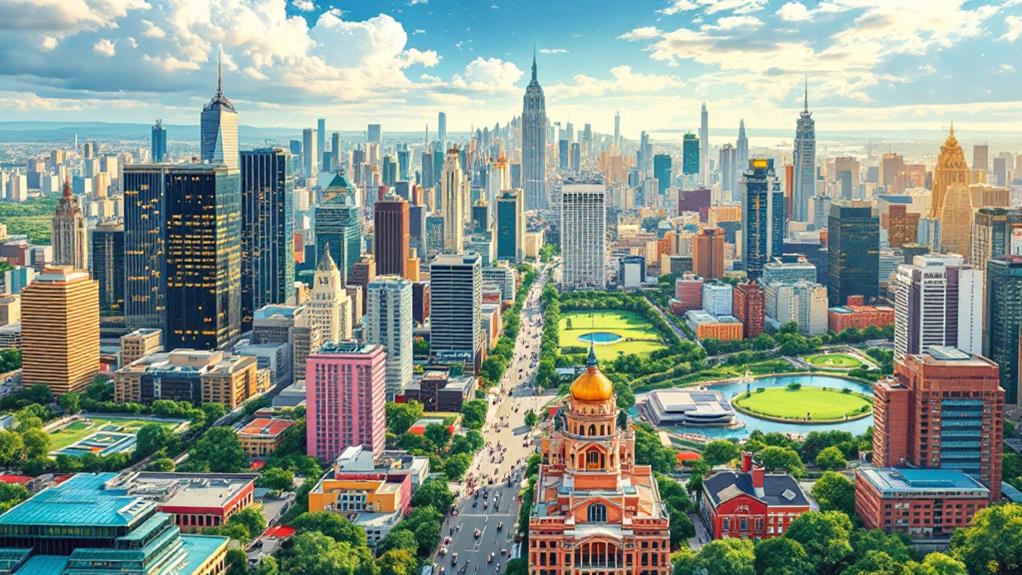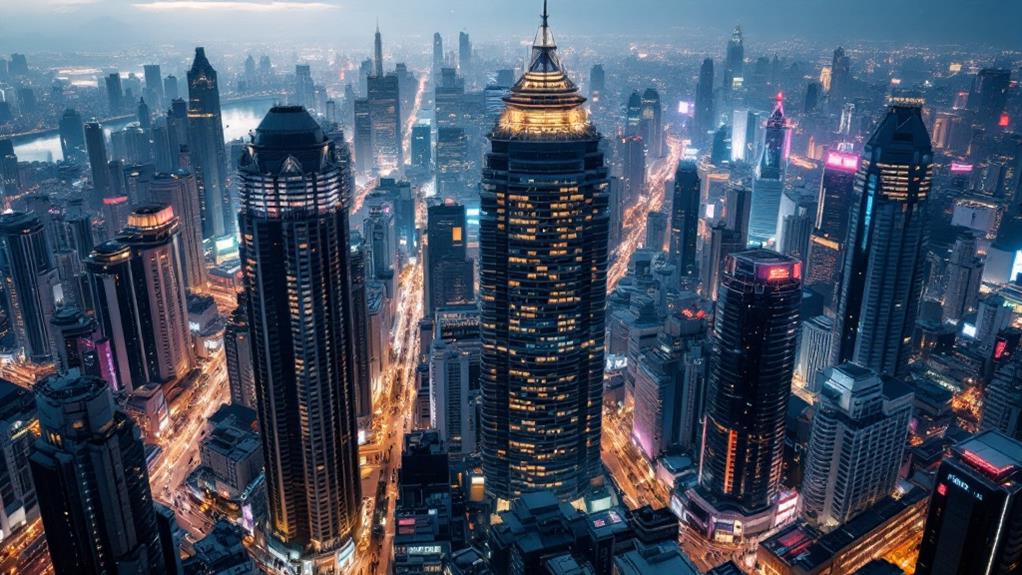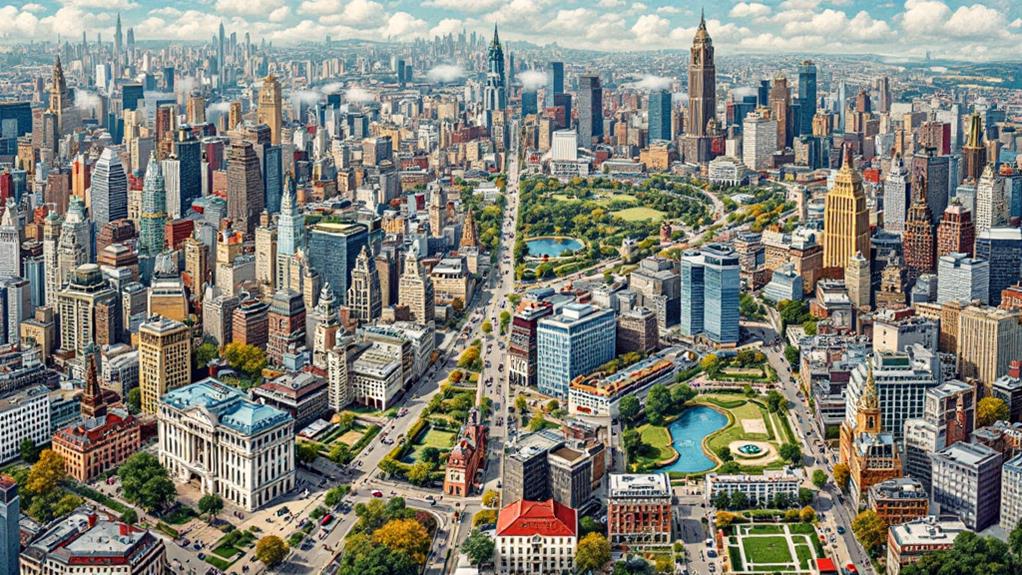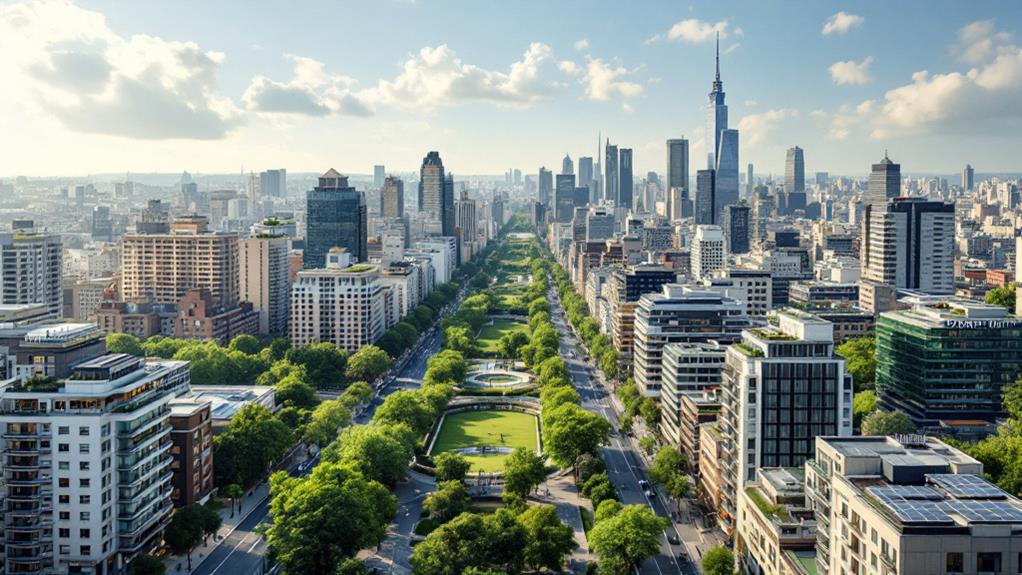A Comparison of Population Density in the Largest Urban Areas

When comparing population densities in the world's largest urban areas, you see stark contrasts. Manila and Dhaka top the list with densities of 119,600 and 106,300 people per square mile, straining resources and infrastructure. Meanwhile, New York City, despite its lively energy, has a notably lower density of 27,747.9 people per square mile. European cities like Monaco and Paris also showcase varied densities, with Monaco at around 25,000 residents per square kilometer. These differences affect housing, transportation, and quality of life. By exploring further, you'll uncover how these dynamics shape the fabric and future of urban living.
Understanding Urban Population Density
When you think about urban population density, it's vital to understand how it shapes the living conditions and infrastructure of a city. Urban areas with high density, such as Manila, which boasts approximately 119,600 people per square mile, show how tightly packed populations can lead to overcrowding. This overcrowding puts immense pressure on housing, transportation, and public services. Likewise, Dhaka experiences a density of around 106,300 residents per square mile, further illustrating the strain on resources that comes with high urban population concentrations.
In contrast, New York City, with a density of about 27,747.9 residents per square mile, highlights the wide variance in urban population density across global cities. This variance affects how cities develop their infrastructure and manage resources. As the world's population continues to concentrate in urban areas, it's projected that by 2050, 68% will live in cities. This shift underscores the significance of sustainable urban planning.
High-density cities like Tokyo-Yokohama, with about 15,000 people per square mile, often develop extensive public transport systems to efficiently handle large commuter volumes. Understanding these dynamics is fundamental for preparing for the future of urban living.
Major Global Megacities
In the present rapidly urbanizing world, major global megacities play a vital role in shaping economic and cultural landscapes. These vast urban agglomerations are characterized by their immense population density and significant influence. Tokyo-Yokohama stands as the largest megacity, boasting a staggering population of approximately 38.5 million residents as of 2020. While it holds this top spot, cities like Delhi and Jakarta are on track to surpass it within the next decade, reflecting the dynamic growth in developing regions.
New York City, a prominent example of a megacity, ranks 8th globally with about 21 million people. Its urban areas exemplify the complex challenges and opportunities such dense populations present. Despite the sheer size of these cities, megacities account for only 8.4% of the global population. Surprisingly, smaller urban areas accommodate nearly twice this percentage, underscoring the diverse distribution of people across the planet.
As megacities continue to expand, understanding their role in global urbanization becomes vital. These urban areas are not just population centers; they're hubs of innovation, culture, and economic activity that shape our world. Embracing their potential while addressing their challenges is fundamental for sustainable development.
High Density Cities in Asia

Why do certain cities in Asia exhibit such high population densities? The primary reasons include rapid urbanization, economic opportunities, and limited land space. High density cities like Dhaka and Manila demonstrate the extreme challenges and vibrancy of urban areas where millions of people coexist in confined spaces. In Dhaka, Bangladesh, the staggering population density of around 106,300 residents per square mile exemplifies the intense pressure on infrastructure and resources. Meanwhile, Manila, Philippines, with approximately 119,600 residents per square mile, showcases an even greater level of urban congestion and community dynamics.
Consider the emotions these facts might evoke:
- Awe: The sheer number of people living in such confined spaces is mind-boggling.
- Concern: High density can lead to extreme strain on infrastructure and resources.
- Admiration: The resilience of residents adapting to such environments is remarkable.
- Urgency: There's a critical need for sustainable urban planning solutions.
In India, Kolkata and Mumbai further illustrate the effects of rapid urbanization with densities of about 24,000 and 32,000 residents per square mile, respectively. Jakarta, Indonesia, also contends with significant challenges from high population density, impacting the environment and infrastructure in the urban area.
European and Israeli Urban Densities
Amidst the intricate urban landscapes of Europe and Israel, population densities tell a compelling story of spatial challenges and energetic city life. In Europe, Monaco stands out with one of the highest population densities, housing about 25,000 residents per square kilometer. This urban area exemplifies the pressures of accommodating a large number of people in a limited space. Likewise, Levallois-Perret in France showcases a remarkable urban density of around 27,000 people per square kilometer. Its compact urban layout efficiently utilizes every square meter to accommodate its lively population.
Paris, another French city, highlights the concentration of residents in its central areas, with a population density of approximately 21,000 residents per square kilometer. This not only reflects the colorful urban life but also the challenges of maintaining infrastructure and services in such densely populated spaces.
Turning to Israel, Bnei Brak stands out with a population density surpassing 30,000 residents per square kilometer. The city's compact residential zones are an illustration of its high urban density. Meanwhile, Tel Aviv, with about 8,500 people per square kilometer, represents the dynamic balance between urban opportunity and residential space, making it a fascinating study of urban living in Israel.
Density Influencers and Variability

Shaped by a variety of factors, urban population density is far from uniform across different cities. You'll notice how geography plays a critical role; natural barriers and available land dictate where people can settle. Economic opportunities are another major influencer; cities bursting with job prospects naturally attract more people, increasing the population density. But it's not just about jobs. Infrastructure quality, especially in transportation and public services, can make or break a city's ability to support a dense population. Efficient systems allow people to move around easily and access vital resources, making urban areas more livable.
Affordable housing also plays a key part. When cities fail to provide enough housing options, it often leads to overcrowding and higher densities. Here's how these factors evoke different emotions:
- Hope: Economic opportunities promise a better future and enhance urban life.
- Frustration: Poor infrastructure quality can make daily life challenging.
- Desperation: Lack of affordable housing feels like an endless struggle for many.
- Optimism: Effective government policies can balance population density.
Ultimately, government policies, zoning laws, and urban planning strategies greatly impact how these elements converge, either promoting or restraining urban development.
Challenges of High Population Density
High population density in urban areas presents a multitude of challenges that directly impact daily life and general well-being. One major issue is the strain on vital resources like water, food, and energy. For instance, cities such as Dhaka, with a staggering density of approximately 106,300 residents per square mile, struggle to meet the basic needs of their inhabitants. Overcrowding is another significant challenge. In places like Manila, where the density reaches 119,600 people per square mile, housing shortages are prevalent, leading to inflated living costs.
Environmental issues are also exacerbated by high population density. In megacities like Tokyo-Yokohama, this results in increased air and water pollution. The competition for limited resources can heighten social unrest, as inadequate infrastructure fails to support the growing population. Crime rates often rise under these conditions, further straining community cohesion.
Public health concerns become more acute in densely populated urban areas. The risk of disease spread is amplified, as seen during the COVID-19 pandemic in major cities. These challenges necessitate careful planning and management to guarantee sustainable urban living conditions and improve overall quality of life.
Solutions for Urban Density Issues

Addressing the challenges of urban density requires a multifaceted approach, incorporating both creative and traditional strategies. You can start by expanding urban green spaces, which improve livability and provide recreational opportunities. In cities like New York, parks play a vital role in mitigating urban heat effects, enhancing mental health, and offering a much-needed escape from the concrete jungle.
To alleviate congestion and reduce reliance on personal vehicles, invest in efficient public transportation systems. Tokyo exemplifies how a well-planned transit network can promote sustainable mobility in high-density urban environments. Reliable public transport makes cities more accessible, less polluted, and easier to navigate.
Affordable housing initiatives are fundamental to guarantee equitable access to living spaces in densely populated areas. Vienna's policies serve as a model for maintaining affordability amidst rising demand. By prioritizing affordable housing, you can prevent displacement and foster more inclusive communities.
Lastly, prioritize community engagement in urban policy-making. Residents' input leads to better-designed public spaces and services that truly meet the diverse needs of the population. Engaging the community fosters a sense of ownership and collaboration, driving more effective solutions.
- Expand Urban Green Spaces
- Invest in Public Transportation
- Implement Affordable Housing Initiatives
- Prioritize Community Engagement
Population Density in U.S. Cities
With its towering skyscrapers and lively streets, New York City stands as the densest large city in the U.S., boasting a population density of approximately 27,747.9 residents per square mile. The sheer number of people living in this busy urban area highlights the unique challenges and liveliness that define city life. As you investigate other U.S. cities, you'll find that San Francisco follows closely behind. Its population density is about 18,790.8 residents per square mile, shaped by its compact urban layout and iconic geography.
Moving on, Boston offers a mix of historical charm and modern living, with a density of 14,362.6 residents per square mile. The city's development over the centuries reflects a concentrated population within its urban area. Miami, a major urban center in Florida, has a density of approximately 13,000.5 residents per square mile. It's a city known for its diverse culture and dynamic lifestyle.



